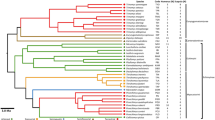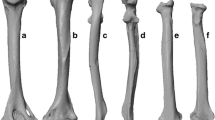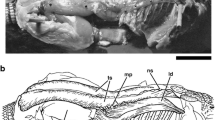Abstract
Hominoidea have adapted to various forms of locomotion, each of which has specific requirements that are reflected in the shape of the scapula. We compared several qualitative and quantitative methods for characterizing the dorsal side of the scapula to detect morphological differences that reflect the adaptations of the scapula to locomotor behaviors. Our sample included 55 specimens of Hominoidea, representing five genera, including Homo, focusing specifically on the relative sizes of the scapular supraspinous and infranspinous fossae. In addition, we weighed the supraspinatus and infraspinatus muscles of 23 of the specimens to examine the feasibility of extrapolating muscle characteristics from osteological data. Our findings confirmed that the five genera exhibit significant differences in the relative size of the supraspinous and the infraspinous fossae that are related to their forms of locomotion. The supraspinous fossa was relatively small in Homo and Pongo but large in Pan, Gorilla, and Hylobates. The analysis of muscle weights showed that a substantial amount of information about soft tissues is lost in osteological analyses, leading us to recommend caution when drawing conclusions regarding forms of locomotion based only on osteological analyses.





Similar content being viewed by others
References
Aiello, L., & Dean, C. (1990). An introduction to human evolutionary anatomy. London: Academic Press.
Ashton, E. H., & Oxnard, C. E. (1963). The musculature of the primate shoulder. Transactions of the Zoological Society of London, 29, 553–650.
Ashton, E. H., & Oxnard, C. E. (1964). Functional adaptations in the primate shoulder girdle. Proceedings of the Zoological Society of London, 142, 49–66.
Ashton, E. H., Oxnard, C. E., & Spence, T. F. (1965). Scapular shape and primate classification. Proceedings of the Zoological Society of London, 145, 125–142.
Ashton, E. H., Flinn, R. M., Oxnard, C. E., & Spence, T. F. (1976). The adaptative and classificatory significance of certain quantitative features of the forelimb in primates. Journal of Zoology, 179, 515–556.
Astúa, D. (2009). Evolution of scapular size and shape in Didelphid marsupials (Didelphimorphia: Didelphidae). Evolution, 63(9), 2438–2456.
Basmajian, J. V., & De Luca, C. J. (1985). Muscles alive: Their functions revealed by electromyography. Baltimore: Williams & Wilkins.
Begun, D. R. (1992). Miocene fossil hominids and the chimp-human clade. Science, 257, 1929–1933.
Bello-Hellegouarch, G., Potau, J. M., Arias-Martorell, J., Pastor, J. F., Diogo, R., & Pérez-Pérez, A. (2012). The rotator cuff muscles in Hominoidea: Evolution and adaptations to different types of locomotion. In E. F. Hughes & M. E. Hill (Eds.), Primates: Classification, evolution and behavior (pp. 111–134). Hauppauge: Nova Science Publishers.
Bookstein, F. L. (1991). Morphometric tools for landmark data: Geometry and biology. Cambridge: Cambridge University Press.
Cartmill, M. (1985). Climbing. In M. Hildebrand, D. M. Bramble, K. F. Liem, & D. B. Wake (Eds.), Functional vertebrate morphology (pp. 73–88). Cambridge: Belknap Press of Harvard University Press.
Corruccini, R. S., & McHenry, H. M. (2001). Knuckle-walking hominid ancestors. Journal of Human Evolution, 40, 507–511.
Crompton, R. W., Vereecke, E. E., & Thorpe, S. K. S. (2008). Locomotion and posture from the common hominoid ancestor to fully modern hominins, with special reference to the last common panin/hominin ancestor. Journal of Anatomy, 212, 501–543.
Crompton, R. W., Sellers, W. I., & Thorpe, S. K. S. (2010). Arboreality, terrestriality and bipedalism. Philosophical Transactions of the Royal Society B: Biological Sciences, 365, 3301–3314.
Dainton, M., & Macho, G. A. (1999). Did knuckle-walking evolve twice? Journal of Human Evolution, 36, 171–194.
Davis, D. D. (1964). The giant panda: A morphological study of evolutionary mechanisms. Fieldiana Zoology Memories III. Chicago Natural History Museum. Chicago.
Depecker, M., Berge, C., Penin, X., & Renous, S. (2006). Geometric morphometrics of the shoulder girdle in extant turtles (Chelonii). Journal of Anatomy, 208, 35–45.
Doran, D. M. (1996). Comparative positional behavior of the African apes. In W. McGrew, L. Marchant, & T. Nishida (Eds.), Great ape societies (pp. 213–224). Cambridge: Cambridge University Press.
Doran, D. M. (1997). Ontogeny of locomotion in mountain gorillas and chimpanzees. Journal of Human Evolution, 32, 323–344.
Dryden, I. L., & Mardia, K. V. (1998). Statistical shape analysis. Chichester: John Wiley & Sons.
Fleagle, J. G. (1999). Primate adaptation and evolution. London: Academic Press.
Frey, H. (1923). Untersuchungen über die Scapula, speziell über ihre äußere Form und deren Abhängigkeit von der Funktion. Anatomy and Embryology, 68(1), 277–324.
Gebo, D. L. (2010). Locomotor function across Primates (including Homo). In C. S. Larsen (Ed.), A companion to biological anthropology (pp. 530–544). Hoboken: Wiley-Blackwell.
Goodall, J. (1965). Chimpanzees of the gombe stream reserve. In I. DeVore (Ed.), Primate behavior (pp. 425–473). New York: Holt Rinehart and Winston.
Gould, S. J. (1966). Allometry and size in ontogeny and phylogeny. Biological Reviews, 41(4), 587–638.
Groves, C. P. (1972). Systematics and phylogeny of gibbons. In D. M. Rumbaugh (Ed.), Gibbon and Siamang (pp. 1–89). New York: I. Karger.
Howell, S. M., Imobersteg, A. M., Seger, D. H., & Marone, P. J. (1986). Clarification of the role of the supraspinatus muscle in shoulder function. Journal of Bone and Joint Surgery, 68(3), 398–404.
Inman, V. T., Saunders, J. B., & Abbott, L. C. (1944). Observations on the function of the shoulder joint. Journal of Bone and Joint Surgery, 26, 1–30.
Inouye, S. E., & Shea, B. T. (1997). What’s your angle? Size correction and bar-glenoid orientation in “Lucy” (AL 288-1). International Journal of Primatology, 18(4), 629–650.
Inouye, S. E., & Taylor, A. B. (2000). Ontogenetic variation in scapular form in African apes. American Journal of Physical Anthropology (Supplement), 30, 185.
Isler, K. (2002). Characteristics of vertical climbing in gibbons. Evolutionary Anthropology (Supplement), 1, 49–52.
Isler, K. (2005). 3D-kinematics of vertical climbing in hominoids. American Journal of Physical Anthropology, 126, 66–81.
Kikuchi, Y. (2010). Comparative analysis of muscle architecture in primate arm and forearm. Anatomia Histologia Empryologia, Journal of Veterinary Medicine, 39, 93–106.
Kikuchi, Y., Takemoto, H., & Kuraoka, A. (2012). Relationship between humeral geometry and shoulder muscle power among suspensory, knuckle-walking, and digitigrade/palmigrade quadrupedal primates. Journal of Anatomy, 220, 29–41.
Kivell, T. L., & Schmitt, D. (2009). Independent evolution of knuckle-walking in African apes shows that humans did not evolve from a knuckle-walking ancestor. Proceedings of the National Academy of Sciences of the USA, 34, 14241–14246.
Klingenberg, C. P. (1996). Multivariate allometry. In L. F. Marcus, M. Corti, A. Loy, G. J. P. Naylor, & D. E. Slice (Eds.), Advances in morphometrics (pp. 23–49). New York: Plenum Press.
Klingenberg, C. P. (2010). MorphoJ: an integrated software package for geometric morphometrics. Molecular Ecology Resources, 11, 353–357.
Kuroda, S. (1992). Ecological interspecies relationships between gorillas and chimpanzees in the Ndoki-Nouabale Reserve, Northern Congo. In N. Itoigawa, Y. Sugiyama, G. Sackett, & R. K. R. Thompson (Eds.), Topics in primatology, Vol. 2: Behavior ecology and conservation (pp. 385–394). Tokyo: University of Tokyo Press.
Larson, S. G. (1988). Subscapularis function in gibbons and chimpanzees: implications for interpretation of humeral head torsion in hominoids. American Journal of Physical Anthropology, 76, 449–462.
Larson, S. G. (1993). Functional morphology of the shoulder in Primates. In D. L. Gebo (Ed.), Postcranial adaptation in nonhuman primates (pp. 45–69). DeKalb: Northern Illinois University Press.
Larson, S. G. (1995). New characters for the functional interpretation of primate scapulae and proximal humeri. American Journal of Physical Anthropology, 98, 13–35.
Larson, S. G. (1996). Estimating humeral torsion on incomplete fossil anthropoid humeri. Journal of Human Evolution, 31, 239–257.
Larson, S. G., & Stern, J. T. (1986). EMG of scapulohumeral muscles in chimpanzee during reaching and “arboreal” locomotion. The American Journal of Anatomy, 176, 171–190.
Larson, S. G., & Stern, J. T. (1987). EMG of chimpanzee shoulder muscles during knuckle-walking: Problems of terrestrial locomotion in a suspensory adapted primate. Journal of Zoology of London, 212, 629–655.
Larson, S. G., & Stern, J. T. (1989). Role of supraspinatus in the quadrupedal locomotion of vervets (Cercopithecus aethiops): Implications for interpretation of humeral morphology. American Journal of Physical Anthropology, 79, 369–377.
Larson, S. G., & Stern, J. T. (1992). Further evidence for the role of supraspinatus in quadrupedal monkeys. American Journal of Physical Anthropology, 87, 359–363.
Larson, S. G., Stern, J. T., & Jungers, W. L. (1991). EMG of serratus anterior and trapezius in the chimpanzee: scapular rotators revisited. American Journal of Physical Anthropology, 85, 71–84.
McHenry, H. (1986). The first bipeds: a comparison of the A. afarensis and A. africanus postcranium and implications for the evolution of bipedalism. Journal of Human Evolution, 15, 177–191.
Michilsens, F., Vereecke, E. E., D’Aout, K., & Aerts, P. (2009). Functional anatomy of the gibbon forelimb: adaptations to a brachiating lifestyle. Journal of Anatomy, 215, 335–354.
Michilsens, F., Vereecke, E. E., D’Aout, K., & Aerts, P. (2010). Muscle moment arms and function of the siamang forelimb during brachiation. Journal of Anatomy, 217, 521–535.
Monteiro, L. R., & Abe, A. S. (1999). Functional and historical determinants of shape in the scapula of Xenarthran mammals: evolution of a complex morphological structure. Journal of Morphology, 241, 251–263.
Morgan, C. C. (2009). Geometric morphometrics of the scapula of South American caviomorph rodents (Rodentia: Hystricognathi): form, function and phylogeny. Mammalian Biology, 74, 497–506.
Müller, H. J. (1967). Form und funktion der scapula, vergleichend analytische studien bei carnivoren und ungulaten. Anatomy and Embryology, 126, 205–263.
Napier, J. R. (1963). Brachiation and brachiators. Symposia of the Zoological Society of London, 10, 183–194.
O’Higgins, P. (2010). The study of morphological variation in the hominoid fossil record: biology, landmarks and geometry. Journal of Anatomy, 197, 103–120.
Orr, C. M. (2005). Knuckle-walking anteater: A convergence test of adaptation for purported knuckle-walking features of African Hominidae. American Journal of Physical Anthropology, 128, 639–658.
Oxnard, C. E. (1967). The functional morphology of the primate shoulder as revealed by comparative anatomical, osteometric and discriminant function techniques. American Journal of Physical Anthropology, 26, 219–240.
Oxnard, C. E. (1968). The architecture of the shoulder in some mammals. Journal of Morphology, 126(3), 249–290.
Oxnard, C. E. (1969). Evolution of the human shoulder: some possible pathways. American Journal of Physical Anthropology, 30, 319–331.
Oxnard, C. E. (1984). The order of man: A biomathematical anatomy of the primates. New Haven: Yale University Press.
Oxnard, C. E., & Neely, P. M. (1969). The descriptive use of neighborhood limited classification in functional morphology: an analysis of the shoulder in primates. Journal of Morphology, 129, 127–148.
Potau, J. M., Bardina, X., & Ciurana, N. (2007). Subacromial space in African Great Apes and subacromial impingement syndrome in humans. International Journal of Primatology, 28, 865–880.
Potau, J. M., Bardina, X., Ciurana, N., Camprubí, D., & Pastor, J. F. (2009). Quantitative analysis of the deltoid and rotator cuff muscles in humans and great apes. International Journal of Primatology, 30, 697–708.
Potau, J. M., Artells, R., Bello, G., Muñoz, C., Monzó, M., Pastor, J. F., et al. (2011). Expression of myosin heavy chain isoforms in the supraspinatus muscle of different primate species: Implications for the study of the adaptation of primate shoulder muscles to different locomotor modes. International Journal of Primatology, 32(4), 931–944.
Remis, M. (1995). Effects of body size and social context on the arboreal activities of lowland gorillas in the Central African Republic. American Journal of Physical Anthropology, 97(4), 413–433.
Richmond, B. G., & Strait, D. S. (2000). Evidence that humans evolved from a knuckle-walking ancestor. Nature, 404, 382–385.
Richmond, B. G., Begun, D. R., & Strait, D. S. (2001). Origin of human bipedalism: the knuckle-walking hypothesis revisited. Yearbook of Physical Anthropology, 44, 70–105.
Roberts, D. (1974). Structure and function of the primate scapula. In F. A. Jenkins (Ed.), Primate locomotion (pp. 171–200). New York: Academic Press.
Rohlf, F. J., & Marcus, L. F. (1993). A revolution in morphometrics. Trends in Ecology & Evolution, 8(4), 129–132.
Rohlf, F. J., & Slice, D. E. (1990). Extensions of the Procrustes method for the optimal superimposition of landmarks. Systematic Biology, 39, 40–59.
Ruvolo, M. (1997). Molecular phylogeny of the hominoids: Inference from multiple independent DNA sequence data sets. Molecular Biology and Evolution, 14, 248–265.
Schmitt, D. (2010). Primate locomotor evolution: Biomechanical studies of primate locomotion and their implications for understanding primate neuroethology. In M. L. Platt & A. A. Ghazanfar (Eds.), Primate neuroethology (pp. 31–63). New York: Oxford University Press.
Schultz, A. H. (1930). The skeleton of the trunk and limbs of higher primates. Human Biology, 2(3), 303–438.
Shea, B. T. (1986). Scapula form and locomotion in chimpanzee evolution. American Journal of Physical Anthropology, 70, 475–488.
Swiderski, D. L. (1993). Morphological evolution of the scapula in tree squirrels, chipmunks, and ground squirrels (Sciuridae): an analysis using thin-plate splines. Evolution, 47, 1854–1873.
Taylor, A. B. (1997). Scapula form and biomechanics in gorillas. Journal of Human Evolution, 33, 529–553.
Taylor, A. B., & Slice, D. E. (2005). A geometric morphometric assessment of the relationship between variation and locomotion in African Apes. In D. E. Slice (Ed.), Modern morphometrics in physical anthropology (pp. 299–318). New York: Kluwer Academic/Plenum Press.
Thompson, W. O., Debski, R. E., Boardman, N. D., Taskiran, E., Warner, J. J. P., Fu, F. H., et al. (1996). A biomechanical analysis of rotator cuff deficiency in cadaveric model. The American Journal of Sports Medicine, 24(3), 286–292.
Thorpe, S. K. S., & Crompton, R. H. (2005). Locomotor ecology of wild orangutans (Pongo pygameus abelli) in the Gunung Leuser ecosystem, Sumatra, Indonesia: a multivariate analysis using log-linear modeling. American Journal of Physical Anthropology, 127, 58–78.
Thorpe, S. K. S., & Crompton, R. H. (2006). Orangutan positional behavior and the nature of arboreal locomotion in Hominoidea. American Journal of Physical Anthropology, 131, 384–401.
Thorpe, S. K. S., Holder, R. L., & Crompton, R. H. (2007). Origin of human bipedalism as an adaptation for locomotion on flexible branches. Science, 316, 1328–1331.
Tutin, C. E., & Fernandez, M. (1985). Foods consumed by sympatric populations of Gorilla g. gorilla and Pan t. troglodytes in Gabon: some preliminary data. International Journal of Primatology, 6, 27–43.
Tuttle, R. H. (1975). Parallelism, brachiation, and hominoid phylogeny. In W. P. Luckett & F. S. Szalay (Eds.), Phylogeny of the primates (pp. 447–480). New York: Plenum Press.
Tuttle, R. H., & Basmajian, J. V. (1978a). Electromyography of pongid shoulder muscles. Part II: deltoid, rhomboid, and “rotator cuff. American Journal of Physical Anthropology, 49, 47–56.
Tuttle, R. H., & Basmajian, J. V. (1978b). Electromyography of pongid shoulder muscles. Part III: Quadrupedal positional behavior. American Journal of Physical Anthropology, 49, 57–70.
Tuttle, R. H., & Watts, D. P. (1985). The positional behavior and adaptative complexes of Pan gorilla. In S. Kondo (Ed.), Primate morphophysiology, locomotor analyses, and human bipedalism (pp. 261–288). Tokyo: University of Tokyo Press.
Ward, C. V. (1997). Functional anatomy and phyletic implications of the hominoid trunk and hindlimb. In D. R. Begun, C. V. Ward, & M. D. Rose (Eds.), Function, phylogeny, and fossils: Miocene hominoid evolution and adaptations (pp. 101–130). New York: Plenum Press.
Ward, C. V. (2007). Postcranial and locomotor adaptations of hominoids. In W. Jenke & I. Tattersall (Eds.), Handbook of paleoanthropology, Vol. II. Primate evolution and human origins (pp. 1011–1030). New York: Springer.
Williams, S. A. (2010). Morphological integration and the evolution of knuckle-walking. Journal of Human Evolution, 58(5), 432–440.
Wolffson, D. M. (1950). Scapula shape and muscle function, with special reference to the vertebral border. American Journal of Physical Anthropology, 8, 331–341.
Young, N. M. (2003). A reassessment of living hominoid postcranial variability: implication for ape evolution. Journal of Human Evolution, 45, 441–464.
Young, N. M. (2006). Function, ontogeny and canalization of shape variance in the primate scapula. Journal of Anatomy, 209, 623–636.
Young, N. M. (2008). A comparison of the ontogeny of shape variation in the Anthropoid scapula: functional and phylogenetic signal. American Journal of Physical Anthropology, 136, 247–264.
Zelditch, M. L., Swiderski, D. L., Sheets, H. D., & Fink, W. L. (2004). Geometric morphometrics for biologists: A primer. Philadelphia: Elsevier Academic Press.
Ziegler, A. C. (1964). Brachiating adaptations of chimpanzee upper limb musculature. American Journal of Physical Anthropology, 22, 15–32.
Zumwalt, A. (2006). The effect of endurance exercise on the morphology of muscle attachment sites. The Journal of Experimental Biology, 209, 444–454.
Acknowledgments
We thank Eulalia Garcia (Museum of Natural Sciences of Barcelona) and Georges Lenglet (Royal Belgian Institute of Natural Sciences) for providing access to specimens under their care, as well as Beatriz Pinilla (University of Barcelona) for her methodological advice. We also thank two anonymous reviewers whose suggestions greatly improved the manuscript. This research was funded by the Spanish Ministry of Education and Science (MEC) projects CGL2010–15340 and CGL2011-22999 to A. Pérez-Pérez, the Generalitat de Catalunya Funding for Consolidate Research Groups (DURSI 2009SGR-00884), and the Predoctoral Fellowship Grant Program of the Ministry of Education and Science (MEC) FPU (AP2008-00877) to G. Bello-Hellegouarch.
Author information
Authors and Affiliations
Corresponding author
Rights and permissions
About this article
Cite this article
Bello-Hellegouarch, G., Potau, J.M., Arias-Martorell, J. et al. A Comparison of Qualitative and Quantitative Methodological Approaches to Characterizing the Dorsal Side of the Scapula in Hominoidea and Its Relationship to Locomotion. Int J Primatol 34, 315–336 (2013). https://doi.org/10.1007/s10764-013-9660-5
Received:
Accepted:
Published:
Issue Date:
DOI: https://doi.org/10.1007/s10764-013-9660-5




